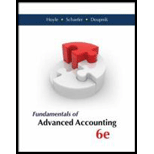
Fundamentals of Advanced Accounting
6th Edition
ISBN: 9780077862237
Author: Joe Ben Hoyle, Thomas Schaefer, Timothy Doupnik
Publisher: McGraw-Hill Education
expand_more
expand_more
format_list_bulleted
Textbook Question
Chapter 1, Problem 1Q
A company acquires a rather large investment in another corporation. What criteria determine whether the investor should apply the equity method of accounting to this investment?
Expert Solution & Answer
To determine
Identify the criteria which determine whether the investor should apply the equity method of accounting to this investment or not.
Explanation of Solution
The criteria for determining whether the investor should apply the equity method of accounting to this investment or not is as follows:
- The investor should invest at least 20% or it should acquire at least 20% of the investee’s share.
- The investor should be able to exercise the significant influence over the investee.
If the above two conditions are fulfilled then the organization can use the equity method.
Want to see more full solutions like this?
Subscribe now to access step-by-step solutions to millions of textbook problems written by subject matter experts!
Students have asked these similar questions
Compute total manufacturing costs.?
Given solution for General accounting question not use ai
Hy expert give me solution this question
Chapter 1 Solutions
Fundamentals of Advanced Accounting
Ch. 1 - A company acquires a rather large investment in...Ch. 1 - Prob. 2QCh. 1 - Why does the equity method record dividends from...Ch. 1 - Prob. 4QCh. 1 - Smith. Inc., has maintained an ownership interest...Ch. 1 - Prob. 6QCh. 1 - Because of the acquisition of additional investee...Ch. 1 - Prob. 8QCh. 1 - Prob. 9QCh. 1 - Prob. 10Q
Ch. 1 - In a stock acquisition accounted for by the equity...Ch. 1 - Prob. 12QCh. 1 - What is the difference between downstream and...Ch. 1 - Prob. 14QCh. 1 - Prob. 15QCh. 1 - What is the fair-value option for reporting equity...Ch. 1 - When an investor uses the equity method to account...Ch. 1 - Which of the following does not indicate an...Ch. 1 - Prob. 3PCh. 1 - Under fair-value accounting for an equity...Ch. 1 - When an equity method investment account is...Ch. 1 - Prob. 6PCh. 1 - Prob. 7PCh. 1 - Prob. 8PCh. 1 - Prob. 9PCh. 1 - Prob. 10PCh. 1 - Prob. 11PCh. 1 - Prob. 12PCh. 1 - Prob. 13PCh. 1 - Prob. 14PCh. 1 - Prob. 15PCh. 1 - Prob. 16PCh. 1 - Prob. 17PCh. 1 - Prob. 18PCh. 1 - Prob. 19PCh. 1 - Prob. 20PCh. 1 - Prob. 21PCh. 1 - Prob. 22PCh. 1 - Prob. 23PCh. 1 - Prob. 24PCh. 1 - Prob. 25PCh. 1 - Prob. 26PCh. 1 - Prob. 27PCh. 1 - Prob. 28PCh. 1 - Prob. 29PCh. 1 - Prob. 30PCh. 1 - Prob. 31PCh. 1 - Prob. 32PCh. 1 - Prob. 33PCh. 1 - Prob. 1DYSCh. 1 - Access The Coca-Cola Companys SEC 10-K filing at...Ch. 1 - Prob. 4DYSCh. 1 - Prob. 5DYS
Knowledge Booster
Learn more about
Need a deep-dive on the concept behind this application? Look no further. Learn more about this topic, accounting and related others by exploring similar questions and additional content below.Similar questions
- Jennifer's business reported annual net credit sales of $850,000 and had beginning accounts receivable of $45,000 and ending accounts receivable of $55,000. What is the accounts receivable turnover ratio for Jennifer's business? a. 17.0 b. 15.5 c. 18.9 d. 21.3arrow_forwardI need helparrow_forwardPlease post this question in Account tutors feedarrow_forward
- Merchandise is soldon account to a customer for $82,500, terms GEB shipping point, 3/10, n/30. The seller paid the freight of $6,300. Determine the amount of the sale.arrow_forwardCan you guide me through solving this financial accounting problem using proper techniques?arrow_forwardAccounting solution and questionarrow_forward
arrow_back_ios
SEE MORE QUESTIONS
arrow_forward_ios
Recommended textbooks for you
 EBK CONTEMPORARY FINANCIAL MANAGEMENTFinanceISBN:9781337514835Author:MOYERPublisher:CENGAGE LEARNING - CONSIGNMENT
EBK CONTEMPORARY FINANCIAL MANAGEMENTFinanceISBN:9781337514835Author:MOYERPublisher:CENGAGE LEARNING - CONSIGNMENT





EBK CONTEMPORARY FINANCIAL MANAGEMENT
Finance
ISBN:9781337514835
Author:MOYER
Publisher:CENGAGE LEARNING - CONSIGNMENT

Financial leverage explained; Author: The Finance story teller;https://www.youtube.com/watch?v=GESzfA9odgE;License: Standard YouTube License, CC-BY